load capacity MERCEDES-BENZ METRIS 2020 MY20 Operator’s Manual
[x] Cancel search | Manufacturer: MERCEDES-BENZ, Model Year: 2020, Model line: METRIS, Model: MERCEDES-BENZ METRIS 2020Pages: 320, PDF Size: 26.38 MB
Page 25 of 320
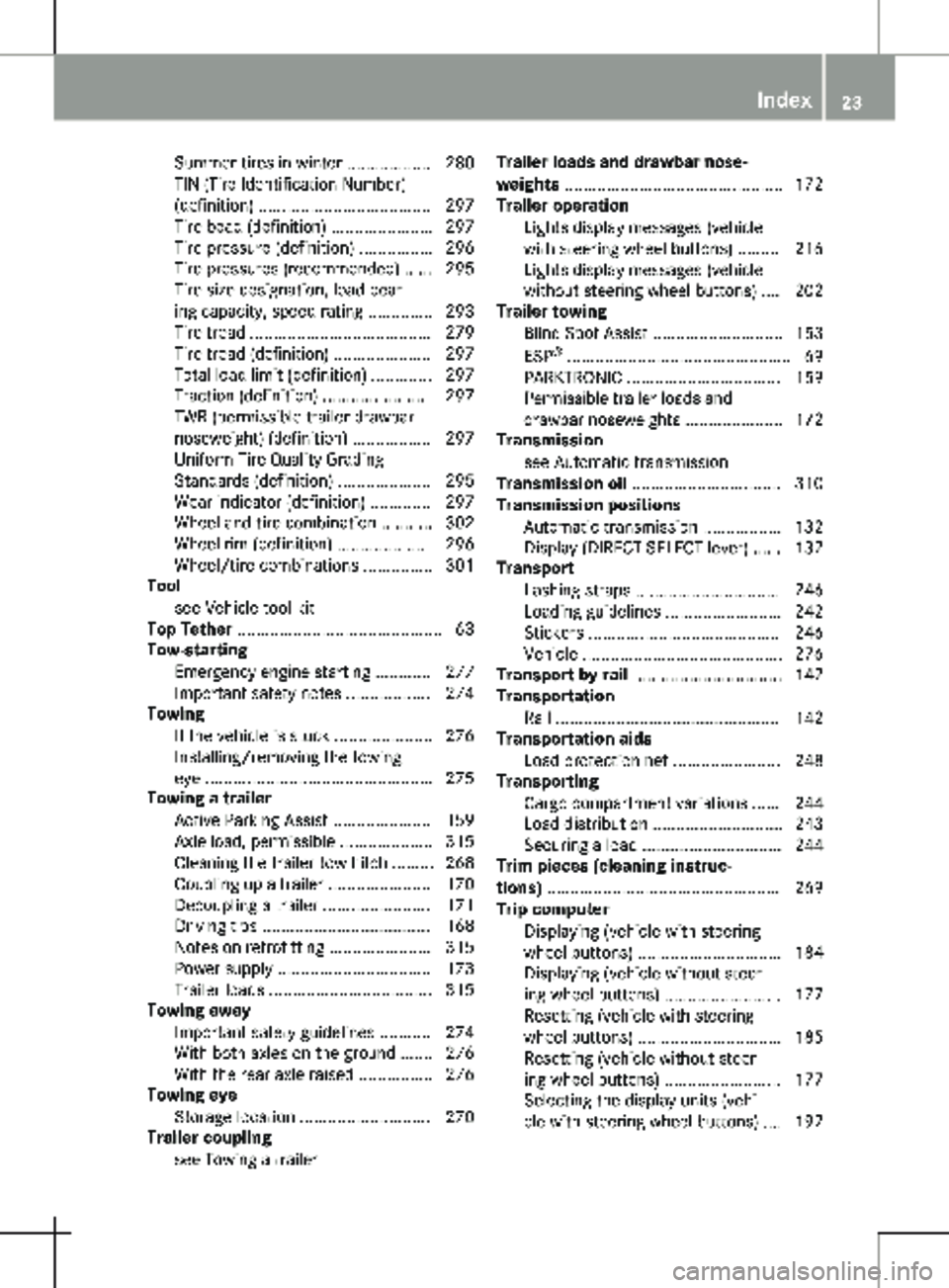
Summer tires in winter .................. 280
TIN (Tire Identification Number)
(definition) .....................................
297
Tire bead (definition) ...................... 297
Tire pressure (definition) ................ 296
Tire pressures (recommended) ...... 295
Tire size designation, load-bear-
ing capacity, speed rating .............. 293
Tire tread ....................................... 279
Tire tread (definition) ..................... 297
Total load limit (definition) ............. 297
Traction (definition) ....................... 297
TWR (permissible trailer drawbar
noseweight) (definition) ................. 297
Uniform Tire Quality Grading
Standards (definition) .................... 295
Wear indicator (definition) ............. 297
Wheel and tire combination ........... 302
Wheel rim (definition) .................... 296
Wheel/tire combinations ............... 301
Tool
see Vehicle tool kit
Top Tether ............................................ 63
Tow-starting
Emergency engine starting ............ 277
Important safety notes .................. 274
Towing
If the vehicle is stuck ..................... 276
Installing/removing the towing
eye ................................................. 275
Towing a trailer
Active Parking Assist ..................... 159
Axle load, permissible .................... 315
Cleaning the trailer tow hitch ......... 268
Coupling up a trailer ...................... 170
Decoupling a trailer ....................... 171
Driving tips .................................... 168
Notes on retrofitting ...................... 315
Power supply ................................. 173
Trailer loads ................................... 315
Towing away
Important safety guidelines ........... 274
With both axles on the ground ....... 276
With the rear axle raised ................ 276
Towing eye
Storage location ............................ 270
Trailer coupling
see Towing a trailer Trailer loads and drawbar nose-
weights
...............................................
172
Trailer operation
Lights display messages (vehicle
with steering wheel buttons) ......... 216
Lights display messages (vehicle
without steering wheel buttons) .... 202
Trailer towing
Blind Spot Assist ............................ 153
ESP ®
................................................ 69
PARKTRONIC ................................. 159
Permissible trailer loads and
drawbar noseweights ..................... 172
Transmission
see Automatic transmission
Transmission oil ................................ 310
Transmission positions
Automatic transmission ................. 132
Display (DIRECT SELECT lever) ...... 132
Transport
Lashing straps ............................... 246
Loading guidelines ......................... 242
Stickers ......................................... 246
Vehicle ........................................... 276
Transport by rail ................................ 142
Transportation
Rail ................................................ 142
Transportation aids
Load protection net ....................... 248
Transporting
Cargo compartment variations ...... 244
Load distribution ............................ 243
Securing a load .............................. 244
Trim pieces (cleaning instruc-
tions) .................................................. 269
Trip computer
Displaying (vehicle with steering
wheel buttons) ............................... 184
Displaying (vehicle without steer-
ing wheel buttons) ......................... 177
Resetting (vehicle with steering
wheel buttons) ............................... 185
Resetting (vehicle without steer-
ing wheel buttons) ......................... 177
Selecting the display units (vehi-
cle with steering wheel buttons) .... 192 Index
23
Page 170 of 320
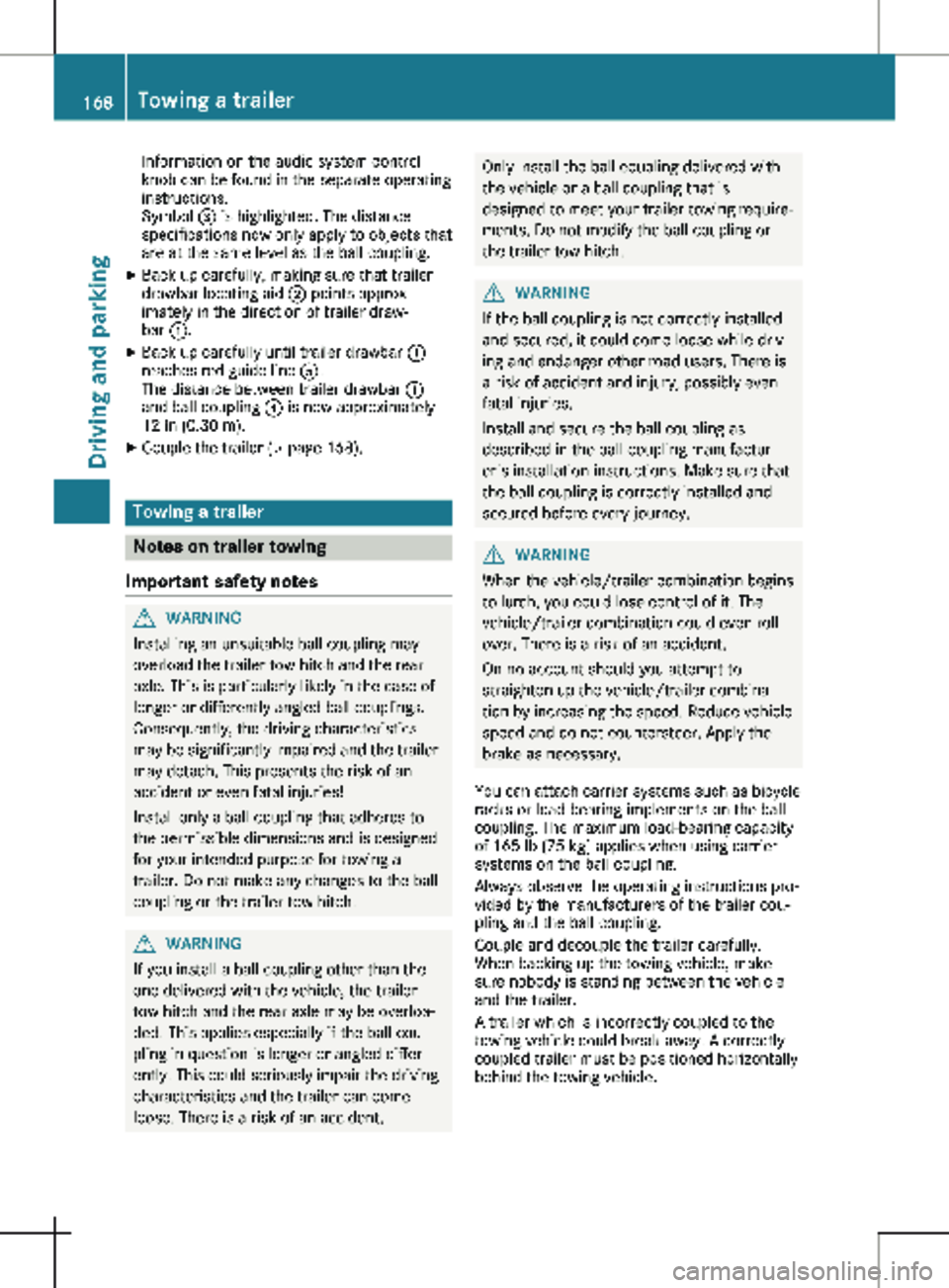
Information on the audio system control
knob can be found in the separate operating
instructions.
Symbol
= is highlighted. The distance
specifications now only apply to objects that
are at the same level as the ball coupling.
X Back up carefully, making sure that trailer
drawbar locating aid ; points approx-
imately in the direction of trailer draw-
bar :.
X Back up carefully until trailer drawbar :
reaches red guide line A.
The distance between trailer drawbar :
and ball coupling ? is now approximately
12 in (0.30 m
).
X Couple the trailer (Y page
168).Towing a trailer
Notes on trailer towing
Important safety notes G
WARNING
Installing an unsuitable ball coupling may
overload the trailer tow hitch and the rear
axle. This is particularly likely in the case of
longer or differently angled ball couplings.
Consequently, the driving characteristics
may be significantly impaired and the trailer
may detach. This presents the risk of an
accident or even fatal injuries!
Install only a ball coupling that adheres to
the permissible dimensions and is designed
for your intended purpose for towing a
trailer. Do not make any changes to the ball
coupling or the trailer tow hitch. G
WARNING
If you install a ball coupling other than the
one delivered with the vehicle, the trailer
tow hitch and the rear axle may be overloa-
ded. This applies especially if the ball cou-
pling in question is longer or angled differ-
ently. This could seriously impair the driving
characteristics and the trailer can come
loose. There is a risk of an accident. Only install the ball coupling delivered with
the vehicle or a ball coupling that is
designed to meet your trailer towing require-
ments. Do not modify the ball coupling or
the trailer tow hitch.
G
WARNING
If the ball coupling is not correctly installed
and secured, it could come loose while driv-
ing and endanger other road users. There is
a risk of accident and injury, possibly even
fatal injuries.
Install and secure the ball coupling as
described in the ball coupling manufactur-
er's installation instructions. Make sure that
the ball coupling is correctly installed and
secured before every journey. G
WARNING
When the vehicle/trailer combination begins
to lurch, you could lose control of it. The
vehicle/trailer combination could even roll-
over. There is a risk of an accident.
On no account should you attempt to
straighten up the vehicle/trailer combina-
tion by increasing the speed. Reduce vehicle
speed and do not countersteer. Apply the
brake as necessary.
You can attach carrier systems such as bicycle
racks or load-bearing implements on the ball
coupling. The maximum load-bearing capacity
of 165 lb (75 kg
) applies when using carrier
systems on the ball coupling.
Always observe the operating instructions pro-
vided by the manufacturers of the trailer cou-
pling and the ball coupling.
Couple and decouple the trailer carefully.
When backing up the towing vehicle, make
sure nobody is standing between the vehicle
and the trailer.
A trailer which is incorrectly coupled to the
towing vehicle could break away. A correctly
coupled trailer must be positioned horizontally
behind the towing vehicle. 168
Towing a trailer
Driving and parking
Page 243 of 320
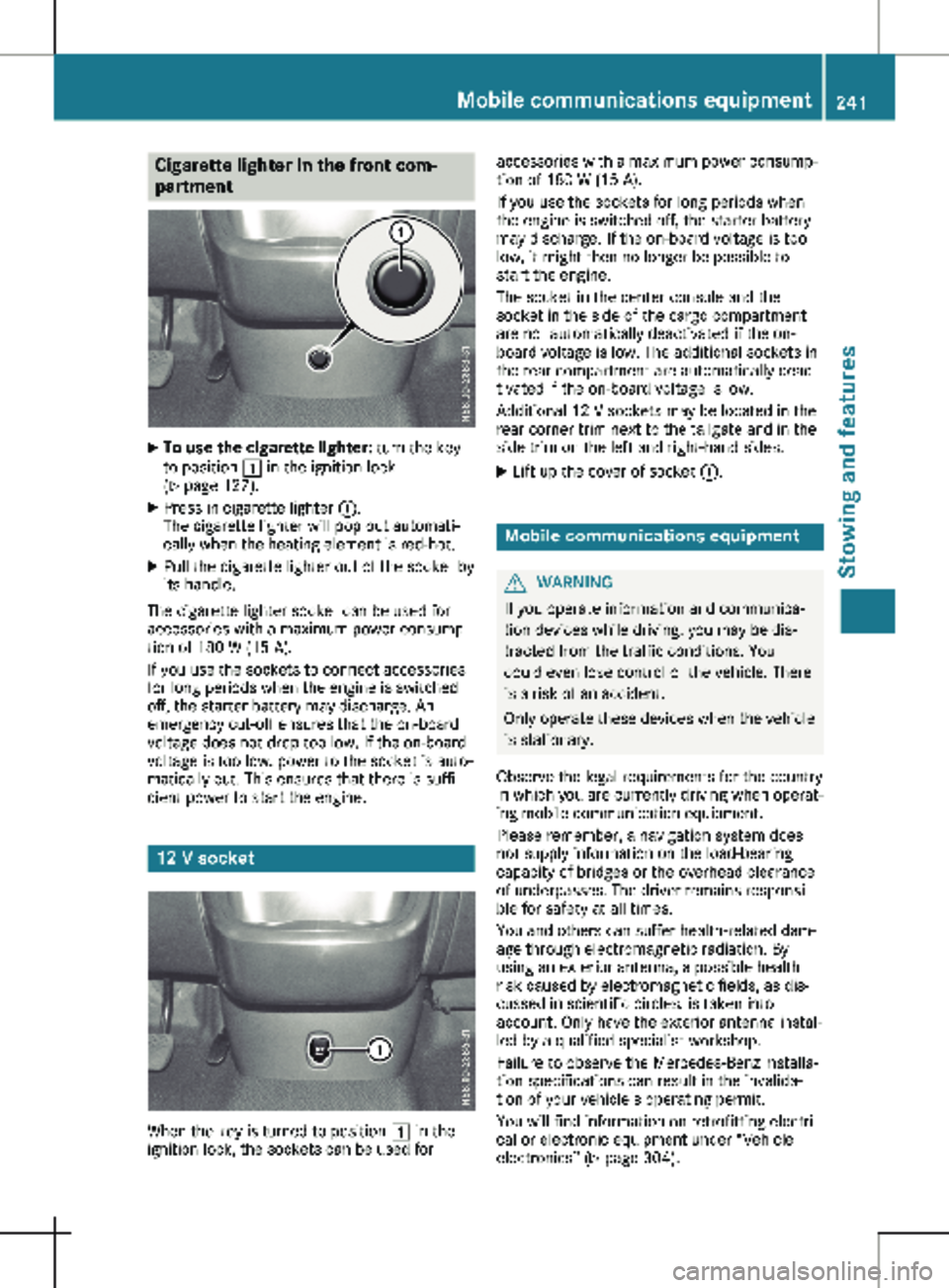
Cigarette lighter in the front com-
partment
X
To use the cigarette lighter: turn the key
to position 1 in the ignition lock
(Y page
127).
X Press in cigarette lighter :.
The cigarette lighter will pop out automati-
cally when the heating element is red-hot.
X Pull the cigarette lighter out of the socket by
its handle.
The cigarette lighter socket can be used for
accessories with a maximum power consump-
tion of 180 W
(15 A).
If you use the sockets to connect accessories
for long periods when the engine is switched
off, the starter battery may discharge. An
emergency cut-off ensures that the on-board
voltage does not drop too low. If the on-board
voltage is too low, power to the socket is auto-
matically cut. This ensures that there is suffi-
cient power to start the engine. 12 V socket
When the key is turned to position 1 in the
ignition lock, the sockets can be used for accessories with a maximum power consump-
tion of
180 W (15 A).
If you use the sockets for long periods when
the engine is switched off, the starter battery
may discharge. If the on-board voltage is too
low, it might then no longer be possible to
start the engine.
The socket in the center console and the
socket in the side of the cargo compartment
are not automatically deactivated if the on-
board voltage is low. The additional sockets in
the rear compartment are automatically deac-
tivated if the on-board voltage is low.
Additional 12 V sockets may be located in the
rear corner trim next to the tailgate and in the
side trim on the left and right-hand sides.
X Lift up the cover of socket :. Mobile communications equipment
G
WARNING
If you operate information and communica-
tion devices while driving, you may be dis-
tracted from the traffic conditions. You
could even lose control of the vehicle. There
is a risk of an accident.
Only operate these devices when the vehicle
is stationary.
Observe the legal requirements for the country
in which you are currently driving when operat-
ing mobile communication equipment.
Please remember, a navigation system does
not supply information on the load-bearing
capacity of bridges or the overhead clearance
of underpasses. The driver remains responsi-
ble for safety at all times.
You and others can suffer health-related dam-
age through electromagnetic radiation. By
using an exterior antenna, a possible health
risk caused by electromagnetic fields, as dis-
cussed in scientific circles, is taken into
account. Only have the exterior antenna instal-
led by a qualified specialist workshop.
Failure to observe the Mercedes-Benz installa-
tion specifications can result in the invalida-
tion of your vehicle's operating permit.
You will find information on retrofitting electri-
cal or electronic equipment under “Vehicle
electronics” (Y page
304). Mobile communications equipment
241
Stowing and features Z
Page 246 of 320
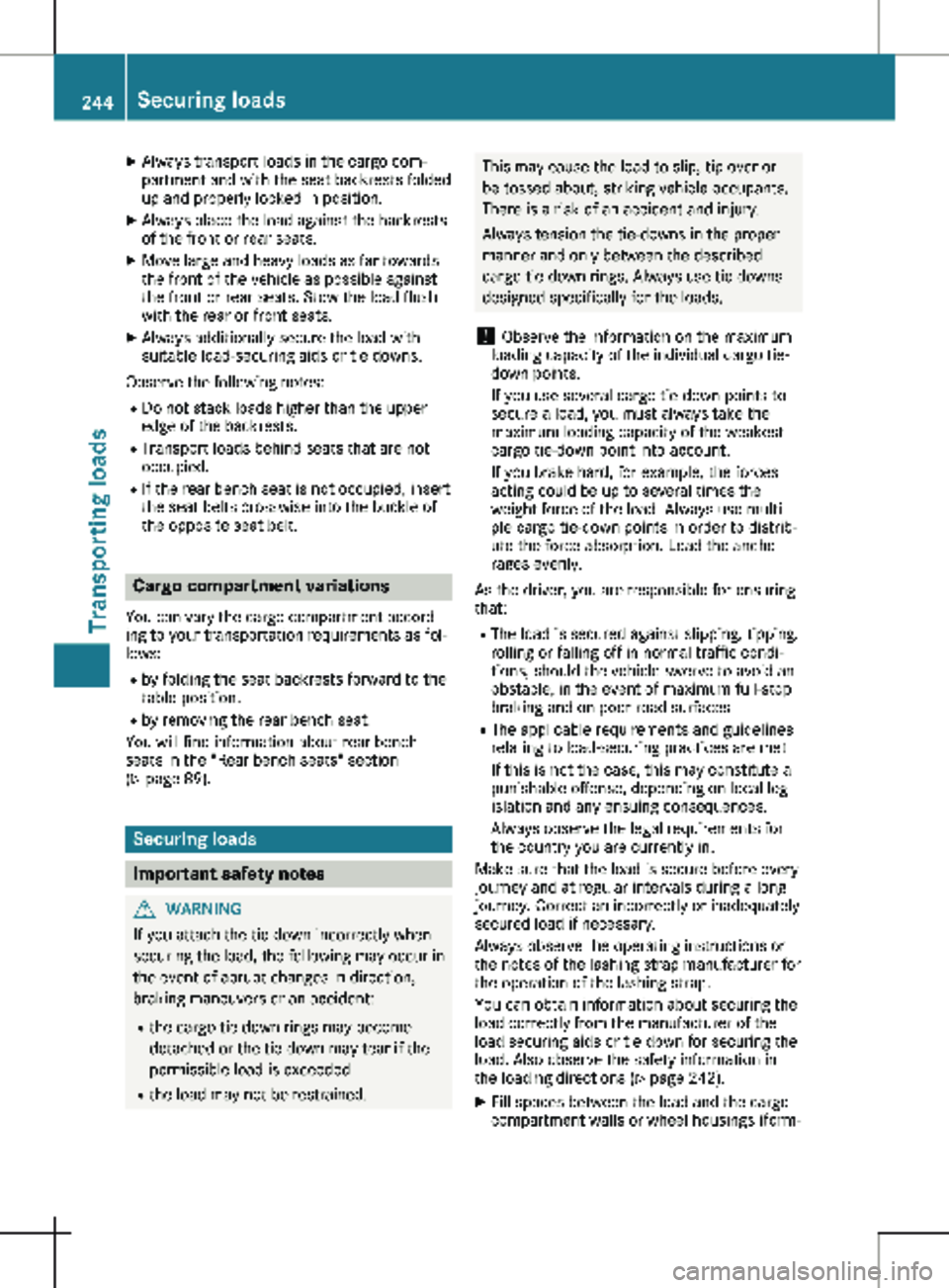
X
Always transport loads in the cargo com-
partment and with the seat backrests folded
up and properly locked in position.
X Always place the load against the backrests
of the front or rear seats.
X Move large and heavy loads as far towards
the front of the vehicle as possible against
the front or rear seats. Stow the load flush
with the rear or front seats.
X Always additionally secure the load with
suitable load-securing aids or tie downs.
Observe the following notes:
R Do not stack loads higher than the upper
edge of the backrests.
R Transport loads behind seats that are not
occupied.
R If the rear bench seat is not occupied, insert
the seat belts crosswise into the buckle of
the opposite seat belt. Cargo compartment variations
You can vary the cargo compartment accord-
ing to your transportation requirements as fol-
lows:
R by folding the seat backrests forward to the
table position.
R by removing the rear bench seat.
You will find information about rear bench
seats in the "Rear bench seats" section
( Y page
89). Securing loads
Important safety notes
G
WARNING
If you attach the tie-down incorrectly when
securing the load, the following may occur in
the event of abrupt changes in direction,
braking maneuvers or an accident:
R the cargo tie-down rings may become
detached or the tie-down may tear if the
permissible load is exceeded
R the load may not be restrained. This may cause the load to slip, tip over or
be tossed about, striking vehicle occupants.
There is a risk of an accident and injury.
Always tension the tie-downs in the proper
manner and only between the described
cargo tie-down rings. Always use tie-downs
designed specifically for the loads.
! Observe the information on the maximum
loading capacity of the individual cargo tie-
down points.
If you use several cargo tie-down points to
secure a load, you must always take the
maximum loading capacity of the weakest
cargo tie-down point into account.
If you brake hard, for example, the forces
acting could be up to several times the
weight force of the load. Always use multi-
ple cargo tie-down points in order to distrib-
ute the force absorption. Load the ancho-
rages evenly.
As the driver, you are responsible for ensuring
that: R The load is secured against slipping, tipping,
rolling or falling off in normal traffic condi-
tions, should the vehicle swerve to avoid an
obstacle, in the event of maximum full-stop
braking and on poor road surfaces
R The applicable requirements and guidelines
relating to load-securing practices are met
If this is not the case, this may constitute a
punishable offense, depending on local leg-
islation and any ensuing consequences.
Always observe the legal requirements for
the country you are currently in.
Make sure that the load is secure before every
journey and at regular intervals during a long
journey. Correct an incorrectly or inadequately
secured load if necessary.
Always observe the operating instructions or
the notes of the lashing strap manufacturer for
the operation of the lashing strap.
You can obtain information about securing the
load correctly from the manufacturer of the
load securing aids or tie down for securing the
load. Also observe the safety information in
the loading directions ( Y page 242).
X Fill spaces between the load and the cargo
compartment walls or wheel housings (form-244
Securing loads
Transporting loads
Page 247 of 320
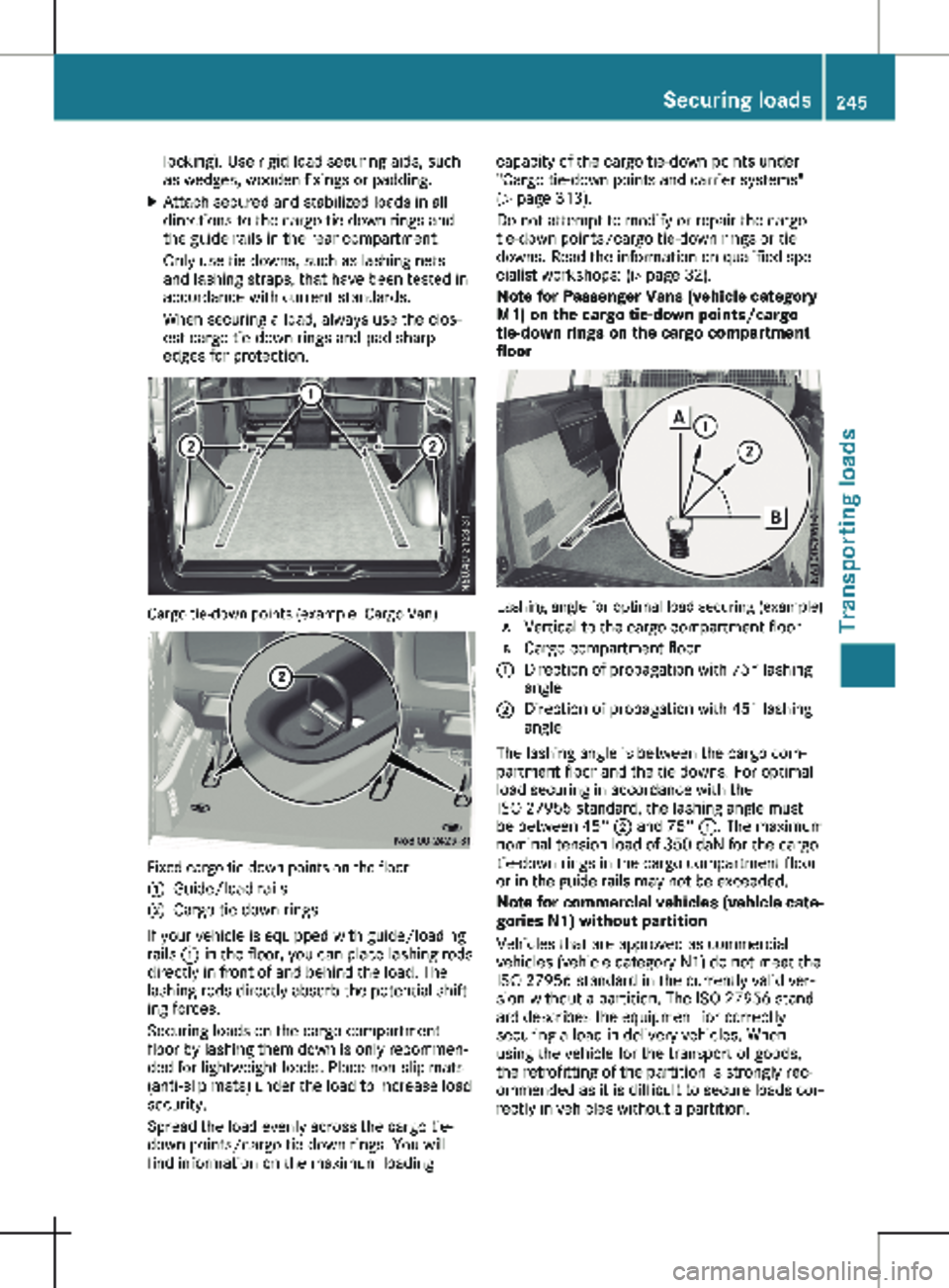
locking). Use rigid load securing aids, such
as wedges, wooden fixings or padding.
X Attach secured and stabilized loads in all
directions to the cargo tie-down rings and
the guide rails in the rear compartment.
Only use tie downs, such as lashing nets
and lashing straps, that have been tested in
accordance with current standards.
When securing a load, always use the clos-
est cargo tie-down rings and pad sharp
edges for protection. Cargo tie-down points (example: Cargo Van)
Fixed cargo tie-down points on the floor
:
Guide/load rails
; Cargo tie-down rings
If your vehicle is equipped with guide/loading
rails : in the floor, you can place lashing rods
directly in front of and behind the load. The
lashing rods directly absorb the potential shift-
ing forces.
Securing loads on the cargo compartment
floor by lashing them down is only recommen-
ded for lightweight loads. Place non-slip mats
(anti-slip mats) under the load to increase load
security.
Spread the load evenly across the cargo tie-
down points/cargo tie-down rings. You will
find information on the maximum loading capacity of the cargo tie-down points under
"Cargo tie-down points and carrier systems"
(Y page
313).
Do not attempt to modify or repair the cargo
tie-down points/cargo tie-down rings or tie
downs. Read the information on qualified spe-
cialist workshops: (Y page 32).
Note for Passenger Vans (vehicle category
M1) on the cargo tie-down points/cargo
tie-down rings on the cargo compartment
floor Lashing angle for optimal load securing (example)
d
Vertical to the cargo compartment floor
e Cargo compartment floor
: Direction of propagation with 75° lashing
angle
; Direction of propagation with 45° lashing
angle
The lashing angle is between the cargo com-
partment floor and the tie downs. For optimal
load securing in accordance with the
ISO 27955 standard, the lashing angle must
be between 45° ; and 75° :. The maximum
nominal tension load of
350 daN for the cargo
tie-down rings in the cargo compartment floor
or in the guide rails may not be exceeded.
Note for commercial vehicles (vehicle cate-
gories N1) without partition
Vehicles that are approved as commercial
vehicles (vehicle category N1) do not meet the
ISO 27956 standard in the currently valid ver-
sion without a partition. The ISO 27956 stand-
ard describes the equipment for correctly
securing a load in delivery vehicles. When
using the vehicle for the transport of goods,
the retrofitting of the partition is strongly rec-
ommended as it is difficult to secure loads cor-
rectly in vehicles without a partition. Securing loads
245
Transporting loads Z
Page 248 of 320
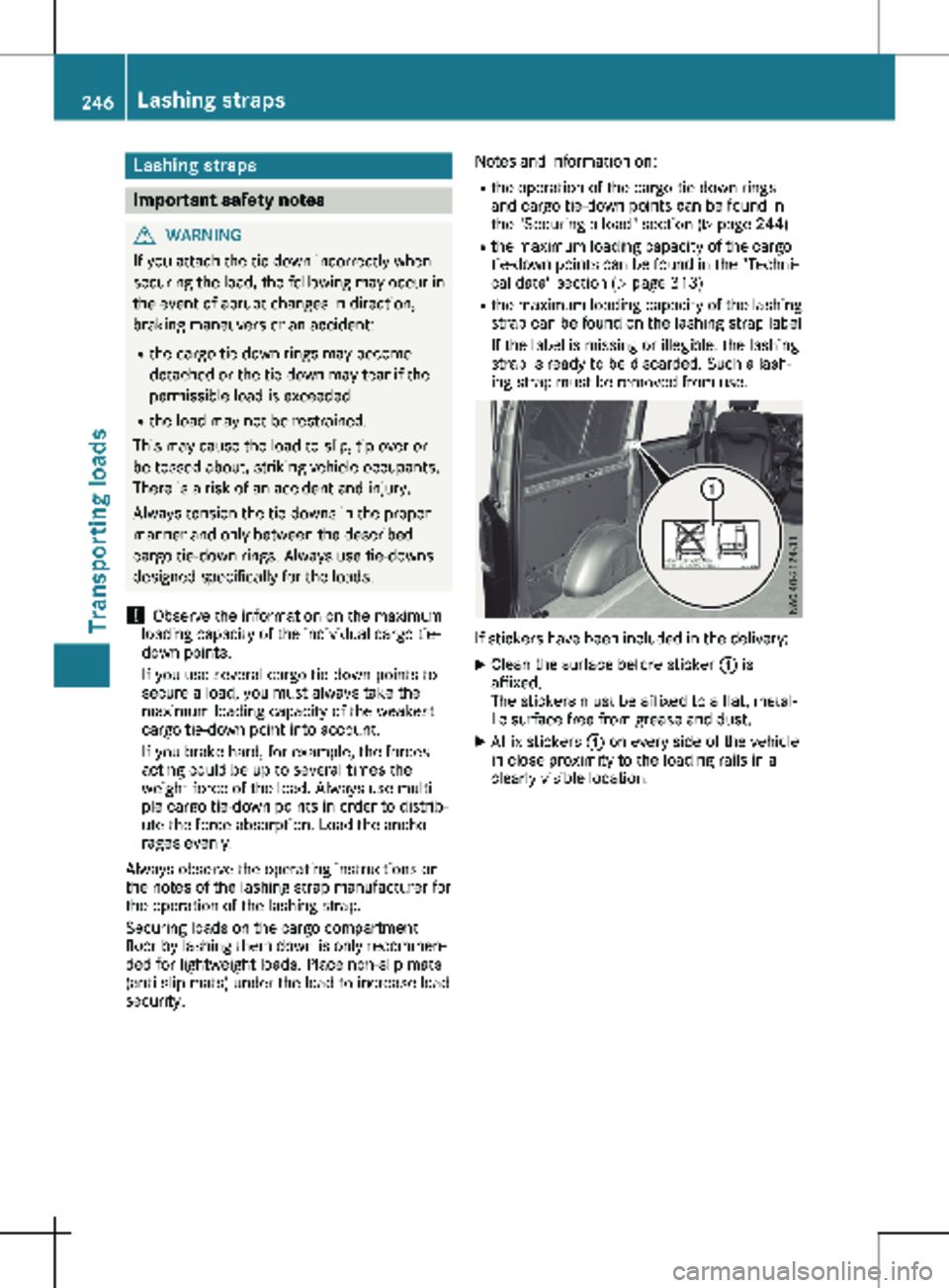
Lashing straps
Important safety notes
G
WARNING
If you attach the tie-down incorrectly when
securing the load, the following may occur in
the event of abrupt changes in direction,
braking maneuvers or an accident:
R the cargo tie-down rings may become
detached or the tie-down may tear if the
permissible load is exceeded
R the load may not be restrained.
This may cause the load to slip, tip over or
be tossed about, striking vehicle occupants.
There is a risk of an accident and injury.
Always tension the tie-downs in the proper
manner and only between the described
cargo tie-down rings. Always use tie-downs
designed specifically for the loads.
! Observe the information on the maximum
loading capacity of the individual cargo tie-
down points.
If you use several cargo tie-down points to
secure a load, you must always take the
maximum loading capacity of the weakest
cargo tie-down point into account.
If you brake hard, for example, the forces
acting could be up to several times the
weight force of the load. Always use multi-
ple cargo tie-down points in order to distrib-
ute the force absorption. Load the ancho-
rages evenly.
Always observe the operating instructions or
the notes of the lashing strap manufacturer for
the operation of the lashing strap.
Securing loads on the cargo compartment
floor by lashing them down is only recommen-
ded for lightweight loads. Place non-slip mats
(anti-slip mats) under the load to increase load
security. Notes and information on:
R the operation of the cargo tie-down rings
and cargo tie-down points can be found in
the "Securing a load" section
(Y page 244)
R the maximum loading capacity of the cargo
tie-down points can be found in the "Techni-
cal data" section ( Y page 313)
R the maximum loading capacity of the lashing
strap can be found on the lashing strap label
If the label is missing or illegible, the lashing
strap is ready to be discarded. Such a lash-
ing strap must be removed from use. If stickers have been included in the delivery:
X Clean the surface before sticker : is
affixed.
The stickers must be affixed to a flat, metal-
lic surface free from grease and dust.
X Affix stickers : on every side of the vehicle
in close proximity to the loading rails in a
clearly visible location. 246
Lashing straps
Transporting loads
Page 259 of 320
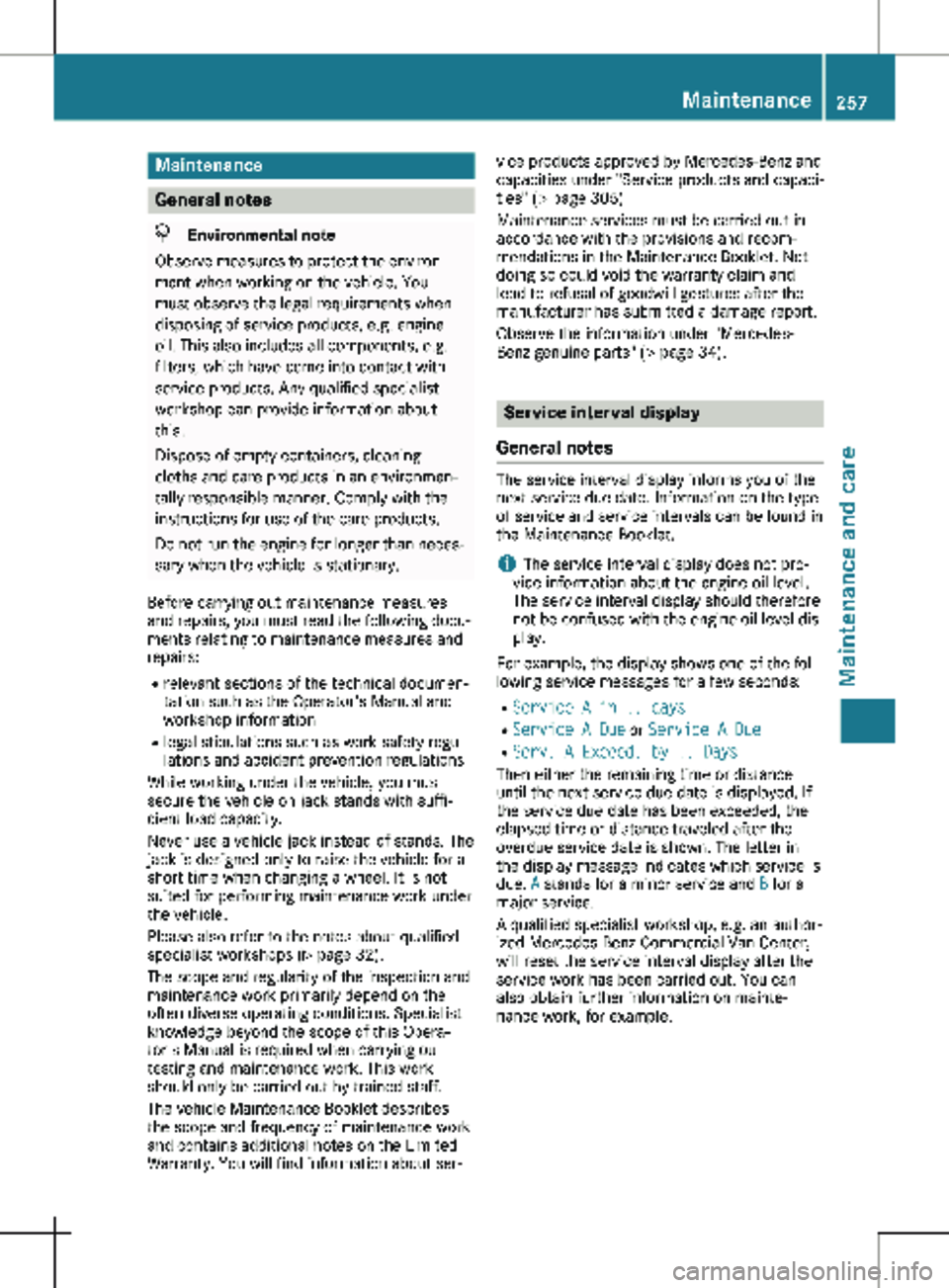
Maintenance
General notes
H
Environmental note
Observe measures to protect the environ-
ment when working on the vehicle. You
must observe the legal requirements when
disposing of service products, e.g. engine
oil. This also includes all components, e.g.
filters, which have come into contact with
service products. Any qualified specialist
workshop can provide information about
this.
Dispose of empty containers, cleaning
cloths and care products in an environmen-
tally responsible manner. Comply with the
instructions for use of the care products.
Do not run the engine for longer than neces-
sary when the vehicle is stationary.
Before carrying out maintenance measures
and repairs, you must read the following docu-
ments relating to maintenance measures and
repairs:
R relevant sections of the technical documen-
tation such as the Operator's Manual and
workshop information
R legal stipulations such as work safety regu-
lations and accident prevention regulations
While working under the vehicle, you must
secure the vehicle on jack stands with suffi-
cient load capacity.
Never use a vehicle jack instead of stands. The
jack is designed only to raise the vehicle for a
short time when changing a wheel. It is not
suited for performing maintenance work under
the vehicle.
Please also refer to the notes about qualified
specialist workshops
(Y page 32).
The scope and regularity of the inspection and
maintenance work primarily depend on the
often diverse operating conditions. Specialist
knowledge beyond the scope of this Opera-
tor's Manual is required when carrying out
testing and maintenance work. This work
should only be carried out by trained staff.
The vehicle Maintenance Booklet describes
the scope and frequency of maintenance work
and contains additional notes on the Limited
Warranty. You will find information about ser- vice products approved by Mercedes-Benz and
capacities under "Service products and capaci-
ties"
(Y page 305)
Maintenance services must be carried out in
accordance with the provisions and recom-
mendations in the Maintenance Booklet. Not
doing so could void the warranty claim and
lead to refusal of goodwill gestures after the
manufacturer has submitted a damage report.
Observe the information under "Mercedes-
Benz genuine parts" (Y page 34). Service interval display
General notes The service interval display informs you of the
next service due date. Information on the type
of service and service intervals can be found in
the Maintenance Booklet.
i The service interval display does not pro-
vide information about the engine oil level.
The service interval display should therefore
not be confused with the engine oil level dis-
play.
For example, the display shows one of the fol-
lowing service messages for a few seconds: R Service A in .. days
R Service A Due or Service A Due
R Serv. A Exceed. by .. Days
Then either the remaining time or distance
until the next service due date is displayed. If
the service due date has been exceeded, the
elapsed time or distance traveled after the
overdue service date is shown. The letter in
the display message indicates which service is
due. A stands for a minor service and B for a
major service.
A qualified specialist workshop, e.g. an author-
ized Mercedes-Benz Commercial Van Center,
will reset the service interval display after the
service work has been carried out. You can
also obtain further information on mainte-
nance work, for example. Maintenance
257
Maintenance and care Z
Page 293 of 320

150 lb passengers in your vehicle, the
amount of available cargo and luggage
load capacity is
650 lbs. (1400 Ò 750 (5 x
150) = 650 lbs.).
(5) Determine the combined weight of lug- gage and cargo being loaded on the vehi-
cle. That weight may not safely exceed the
available cargo and luggage load capacity
calculated in Step 4.
(6) If your vehicle will be towing a trailer, load from your trailer will be transferred to your vehicle. Consult this manual to determine
how this reduces the available cargo and
luggage load capacity of your vehicle.
The vehicle placard named in Step 1 is the Tire
and loading information placard for your vehi-
cle.
Please note that not all vehicles are approved
for trailer operation. Trailer operation is only
permitted when a trailer hitch is installed
(Y page
315). If in doubt, please consult a
qualified specialist workshop. Example: Steps 1 to 3
The following table shows examples of how to calculate total load and cargo capacities with vary-
ing seating configurations and number and size of occupants. The following examples use a max-
imum load of
1500 lbs (680 kg). This is for illustration purposes only. Make sure you are
using the actual load limit for your vehicle stated on your vehicle's Tire and Loading Information
placard . Example 1 Example 2 Example 3
Step 1 Combined maximum
weight of occupants
and cargo (data from
the Tire and Loading
Information placard)
1500 lbs
(680 kg
) 1500 lbs
(680 kg
) 1500 lbs
(680 kg
) Example 1 Example 2 Example 3
Step 2 Number of people in
the vehicle (driver
and occupants)
5 3 1
Distribution of the
occupants
Front: 2
Rear: 3 Front: 1
Rear: 2 Front: 1
Weight of the occu-
pants
Occupant 1:
150 lbs (68 kg
)
Occupant 2:
180 lbs (82 kg)
Occupant 3:
160 lbs (73 kg)
Occupant 4:
140 lbs (63 kg)
Occupant 5:
120 lbs (54 kg) Occupant 1:
200 lbs (91 kg
)
Occupant 2:
190 lbs (86 kg)
Occupant 3:
150 lbs (68 kg) Occupant 1:
150 lbs (68 kg
) Gross weight of all
occupants
750 lbs (340 kg) 540 lbs (245 kg) 150 lbs (68 kg)Loading the vehicle
291
Wheels and tires Z
Page 294 of 320

Example 1 Example 2 Example 3
Step 3 Permissible load and
trailer load/trailer
tongue load (maxi-
mum permissible
gross weight from
the Tire and Loading
Information placard
minus the gross
weight of all occu-
pants)
1500 lbs
(680 kg
) Ò
750 lbs (340 kg)
= 750 lbs
(340 kg) 1500 lbs
(680 kg
) Ò
540 lbs (245 kg)
= 960 lbs
(435 kg) 1500 lbs
(680 kg
) Ò
150 lbs (68 kg)
= 1350 lbs
(612 kg) The greater the combined weight of the occupants, the lower the maximum luggage load.
You can find further information under: "Trailer tow hitch"
(Y page 315).Vehicle identification plate
Even if you have calculated the total load care-
fully, you should still make sure that the per-
missible gross weight and the gross axle
weight rating of your vehicle are not exceeded.
This data can be found on the vehicle identifi-
cation plate on the B-pillar of your vehicle
(Y page
304).
Gross Vehicle Weight Rating (GVWR): the
gross weight of the vehicle, all occupants, load
and trailer load/trailer tongue load (if applica-
ble) must not exceed the permissible gross
vehicle weight.
Gross Axle Weight Rating (GAWR): the maxi-
mum permissible load that can be carried by
one axle (front or rear axle).
To ensure that your vehicle does not exceed
the maximum permissible values (gross vehi-
cle weight and maximum gross axle weight rat-
ing), have your loaded vehicle (including driver,
occupants, load, and full trailer load if applica-
ble) weighed on a suitable vehicle weigh-
bridge. Trailer load/trailer tongue load
The trailer load/trailer tongue load affects the
gross weight of the vehicle. If a trailer is
attached, the trailer load/trailer tongue load is
included in the load along with occupants and
luggage. The trailer load/trailer tongue load is
usually approximately
10% of the gross weight
of the trailer and its load. What you should know about wheels
and tires
Tire labeling
Tire labeling :
DOT, Tire Identification Number
(Y page
294)
; Maximum tire load (Y page
294)
= Maximum tire pressure ( Y page
285)
? Manufacturer
A Tire material ( Y page
295)
B Tire size designation, load-bearing capacity
and speed index
(Y page 293)
C Tire name292
What you should know about wheels and tires
Wheels and tires
Page 295 of 320

The markings described above are on the tire
in addition to the tire name (sales designation)
and the manufacturer's name.
i Tire data is vehicle-specific and may devi-
ate from the data in the example.
Tire size designation, load bearing
index and speed index G
WARNING
Exceeding the stated tire load-bearing capa-
city and the approved maximum speed
could lead to tire damage or the tire burst-
ing. There is a risk of accident.
Therefore, only use tire types and sizes
approved for your vehicle model. Observe
the tire load rating and speed rating
required for your vehicle. :
Tire width
; Nominal aspect ration in %
= Tire code
? Rim diameter
A Load bearing index
B Speed index
Tire width: tire width : shows the nominal
tire width in millimeters.
Aspect ratio: aspect ratio ; is the size ratio
between the tire height and tire width and is
shown in percent. The aspect ratio is calcula-
ted by dividing the tire width by the tire height.
Tire code: tire code = specifies the tire type.
"R" represents radial tires. "D" represents
diagonal tires, "B" represents diagonal radial
tires.
Rim diameter: rim diameter ? is the diame-
ter of the bead seat, not the diameter of the rim flange. The rim diameter is specified in
inches (in).
Load-bearing index: load-bearing index
A is
a numerical code that specifies the maximum
load-bearing capacity of a tire.
Do not overload the tires by exceeding the
specified load limit. The maximum permissible
load can be found on the vehicle's Tire and
Loading Information placard on the B-pillar
on
the driver's side (Y page 289).
Example:
The load-bearing index 101 indicates a maxi-
mum load of 1819 lb (825 kg) for the tire. If
two load-bearing indices are specified, the first
number specifies the load-bearing capacity for
single tires, the second the load-bearing capa-
city for twin tires. For further information on
the maximum tire load in kilograms and
pounds, see (Y page 294). For further information on the load-bearing
index, see "Load index" (Y page 294).
Speed rating: speed rating B specifies the
approved maximum speed of the tire.
Regardless of the speed index always observe
the speed limits. Drive carefully and adapt
your driving style to the traffic conditions.
i Tire data is vehicle-specific and may devi-
ate from the data in the example. Index Speed rating
Q up to 100 mph (160 km/h)
R up to 106 mph (170 km/h)
S up to 112 mph (180 km/h)
T up to 118 mph (190 km/h)
H up to 130 mph (210 km/h)
V up to 149 mph (240 km/h)
W up to 168 mph (270 km/h)
Y up to 186 mph (300 km/h)
i
Not all tires that have the
M+S identifica-
tion offer the driving characteristics of win-
ter tires. In addition to the M+S marking,
winter tires also have the i snowflake
symbol on the tire wall. Tires with this mark-
ing fulfill the requirements of the Rubber
Manufacturers Association (RMA) and the
Rubber Association of Canada (RAC) regard- What you should know about wheels and tires
293
Wheels and tires Z